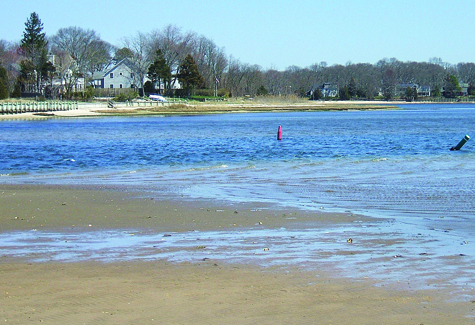Riverhead Town charting waters for stormwater plan

Riverhead Town officials are in the process of finalizing a plan of action to comply with new federal and state mandates aimed at improving water quality in the bays and Sound.
Under orders from both the U.S. Environmental Protection Agency and state Department of Conservation, the town not only must act to improve quality in waters that fail to meet federal clean water standards but must also record and report each plan developed and each step taken.
The DEC has designated the Town of Riverhead as a municipal separate storm sewer system operator, commonly known as MS4. The MS4 designation means the town must develop, implement and enforce a stormwater management program requiring developers to submit more stringent pollution prevention plans to ensure building projects don’t contaminate wetlands.
Water that runs off impervious surfaces, such as rooftops, roads and parking lots, picks up pollutants before descending into nearby waterways. Through stormwater mitigation, pollutants are typically redirected and filtered through permeable surfaces.
Drew Dillingham, an assistant engineer for Riverhead Town who was hired specifically to develop the town’s MS4 plan, said the federal mandates will be added to the town’s existing Watershed Improvement Strategy.
The biggest challenge the town faces to being in compliance is funding, Mr. Dillingham said. The second biggest hurdle? Manpower.
“There aren’t a whole lot of people that you could hire that could step in and run the MS4 program,” he said. “There are many proposed projects, but we don’t have any money … All we did last year was we met paperwork deadlines.”
Riverhead Town Supervisor Sean Walter described the new mandates as a “paper chase.”
“The DEC couldn’t handle it, now the towns are mandated to handle it,” Mr. Walter said. “Having the towns act as a conduit to the DEC makes zero sense.”
Mr. Walter said he believes the MS4 program was initially designed to protect surface waters but has turned into a groundwater protection plan.
“The MS4 program was designed to stop surface water from seeping into streams and creeks,” he said. “It was to protect surface water, which we don’t have a lot of. Groundwater is the DEC’s jurisdiction. This is another one of those unfunded mandates [and] it has no business being dealt with by the town.”
Although the town has dealt with developing a MS4 program, it has also mapped out several stormwater mitigation projects throughout the area.
Mr. Dillingham said two projects at the top of the town’s wish list are construction of a new wetland off Church Lane and a stormwater mitigation plan at Meeting House Creek Park.
A 230-by-110-foot portion of the southern end of Church Lane is slated for a $122,000 project to reconstruct a degraded wetland. Oily runoff and dumping has taken place there for the past few decades.
The Meeting House Creek Park is slated for a bioretention project. This involves layering gravel and soil in order to create a permeable surface and filter pollutants. A catch basin is also planned to be installed to help with the filtering process.
Several other stormwater mitigation projects are currently in the town’s pipeline.
Bioretention and grass pavers are slated for the end of Cedar Street. With a grass paver method, patterned, hollowed-out bricks act as reinforcement for a soil bed where grass is grown. This allows roots and plants to grow while the soil is kept from becoming too compacted and less porous.
An organic filter, which uses leaf compost instead of engineered soil, as well as a small recharge basin are planned for the intersection of Church Lane and Crystal Drive.
A combination of bioretention, grass pavers and rain gardens are planned for the end of Harbor Road. A rain garden is another method used to filter stormwater. Water is redirected through a gutter’s downspout and onto a gravel path leading to a rain garden, which retains water in a deep depression dug out from underneath the vegetation. Water collected in the depression will also help keep lawns moist so less water will be needed to keep them green.
“I wanted to try different measures in different areas,” Mr. Dillingham said. “We’ll be able to use these different methods for educational purposes.”
He added that high school students, as well as the general public, will be given an opportunity to learn about the process of creating these stormwater mitigation measures as construction gets under way.
While the town looks for ways to fund these projects, it also plans to develop a plan to reduce nitrogen-loading in the Great Peconic Bay watershed.








